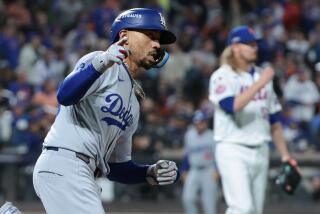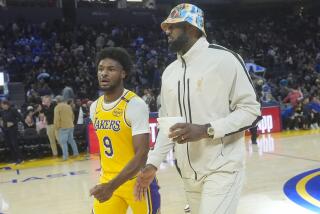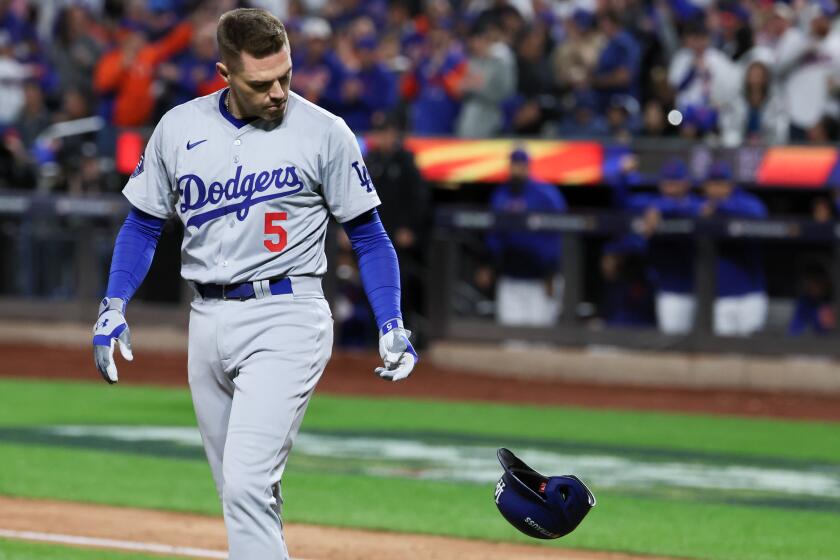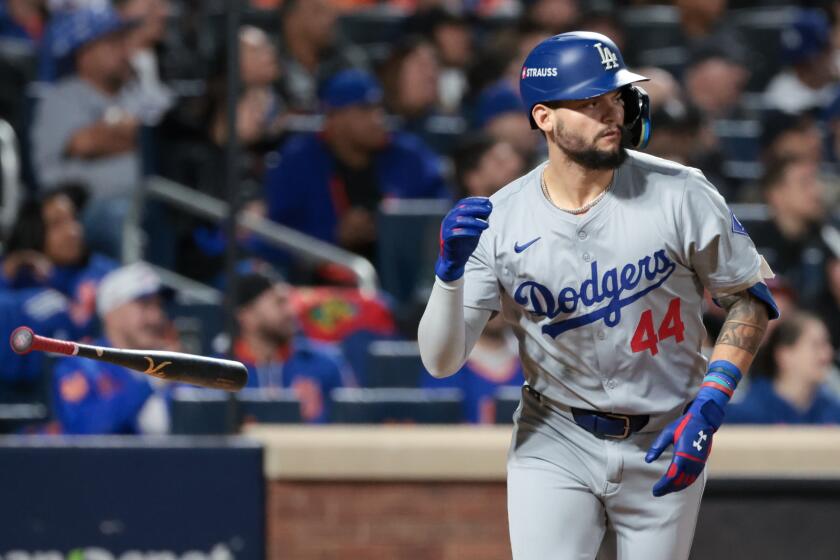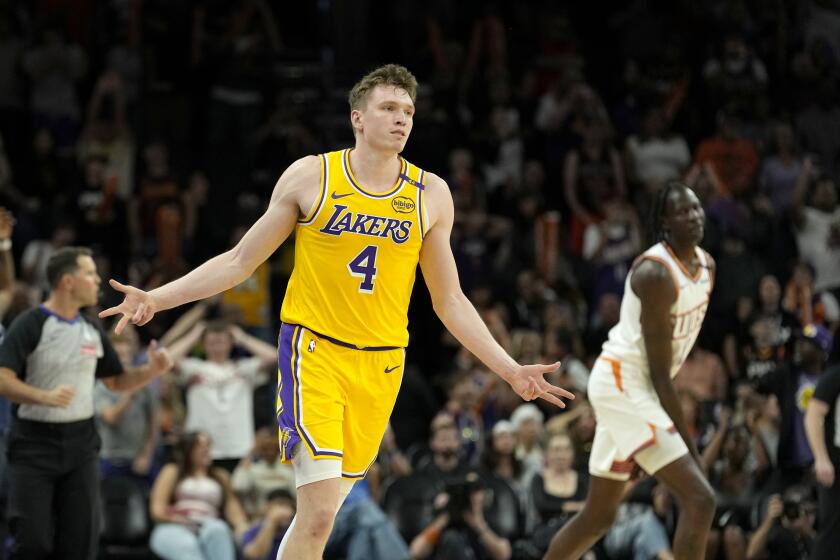49er Win Is One for the Ages
Before the planet spins too many more times, let’s take another look at one of the most remarkable football games of recent years, the one that San Francisco quarterback Steve Young won from Green Bay last Sunday with a high-velocity pass in the last three seconds, 30-27.
Although Young is the only six-time passing champion since Sammy Baugh, that was his career throw, the NFL’s throw of the year, possibly the decade, the best I’ve seen in 63 seasons of football.
For 25 yards, the winning pass traveled fast and true. Moving so rapidly that no viewer’s eye and no camera could keep up with the ball, it dramatically ended an afternoon of big plays by the quarterbacks, Young versus Brett Favre; by the running backs, Garrison Hearst versus Green Bay’s rejuvenated Dorsey Levens, and by the defensive end who made the difference--who made it possible for Young to knock Green Bay out of the playoffs--Charles Haley.
Haley had spent the regular seasons of 1997 and ’98 in retirement, rejoining the 49ers the day before the game, in time to turn the game against the Packers. He did this with four timely defensive moves, two on Levens’ running plays, two on Favre’s passes.
The 49ers wouldn’t have outscored Green Bay without Haley and Young. They wouldn’t have come close.
*
Body pass: Young zinged the game-deciding pass down the middle past a picket line of Packers. there were six Packer defensive backs in the end zone, and to reach wide receiver Terrell Owens, Young had to get the ball over three of them, and between two others. Some call this throwing into a crowd. The way to do it right is the way Young did it. He threw the ball so hard and straight that of all the players who might have put a hand on it, theoretically, only Owens could.
Owens’ single responsibility on that play was to hold onto the ball. It was a fastball that came right at him with such velocity that if it had been a few inches left, or right, or higher, he couldn’t have held it. The ball’s location made it Owens’ easiest catch of the season, one he couldn’t drop, even on an otherwise off day.
Complicating things at the start of the play, a 49er blocker had briefly stumbled into Young’s way and tripped him as he retreated into his three-step drop. He managed to keep his balance but as he turned to throw, he was a tick late in his timing. Owens cut into a small hole in the end zone and what happened next happened so fast that it seemed as if Young’s body were reacting to Owens’ cut.
His body seemed to be saying, “Before the Packers close in, zing it now.”
No problem. No windup. No nothing, just zing.
*
Best ever: One issue is whether that play had the greatness of two other famous last-minute San Francisco plays in the years when Joe Montana was still the quarterback. In 1982, Montana delivered a six-yard pass to wide receiver Dwight Clark to beat Dallas, 28-27, in “The Catch” game for the NFC championship. In 1989, his 10-yard pass to wide receiver John Taylor beat Cincinnati in Super Bowl XXIII, 20-16.
Those two throws meant more to the 49ers. Winning a Super Bowl or a conference championship is more impressive than winning a wild-card game. But neither of Montana’s big passes required the skill that Young needed Sunday to throw the ball harder on a harder play. As a pass, neither of Montana’s big throws were as great.
The important thing about “The Catch” is that the play was a beautifully designed, well rehearsed short-pass play. Even though Clark was a secondary receiver, his role had been staked out by the designer of the West Coast offense, 49er Coach Bill Walsh, and Clark closely followed Walsh’s directions, which obliged him to make one last cut to his right in the end zone as Montana threw.
“We’ve been working on it since training camp,” Clark said afterward. For Montana, “The Catch” requirement was a roll-out touch pass. It traveled so high and softly that the only question was whether Clark could get his fingers on it. He could.
The Montana-Taylor touchdown play in the last 34 seconds of the 1989 Super Bowl was the simplest play of the three. As Taylor ran a short slant pattern into the end zone, he was wide open when Montana went to him. The memorable thing about that game was the way Montana led the 49ers on two long touchdown drives after Cincinnati had led twice in the fourth quarter.
The memorable thing about the 49er game last Sunday was the way it ended with Young’s long laser-like pass.
*
The champion: Lineman Haley came back from two years off to give the 49ers a pass rush, at last, in Sunday’s game. Nothing else the 49ers had, even Young’s passing, had more to do with beating Green Bay than that. In San Francisco since then, Haley has been underappreciated and undercovered because he always is. But his work speaks for itself.
After Haley’s long layoff, the 49ers used him properly, in spots. And to begin with, the Packers tried to run at him, which was also proper considering the layoff. But on their first run at Haley, he stuffed Levens after handling Green Bay offensive tackle Ross Verba.
Next, the Packers tried to sweep Haley, but running outside didn’t succeed, either, even though Verba held Haley illegally. From that point on, through the entire second half, Levens was not a factor. The Packers simply did not use him whenever Haley was in the game.
In the second half, Haley turned his attention to the Packer pass offense and made two rushes at Favre that cost Green Bay, in the aggregate, 11 points.
On one play, storming inside Verba, Haley went at Favre with both hands up and Favre threw the interception that led to a 49er touchdown pass, Young to tight end Greg Clark.
On his other key rush, the Packers had a receiver open for what probably would have been a first down, except that Favre took one last look at Haley and threw the ball into the ground. When Green Bay settled for a field goal on that series, Haley had earned the 49ers a likely four points on one rush--or, in all, 11 points on two rushes at the passer.
Thus, Haley that day earned about $909 per point. The 49ers paid him $10,000 for the Green Bay game.
More to Read
Go beyond the scoreboard
Get the latest on L.A.'s teams in the daily Sports Report newsletter.
You may occasionally receive promotional content from the Los Angeles Times.
